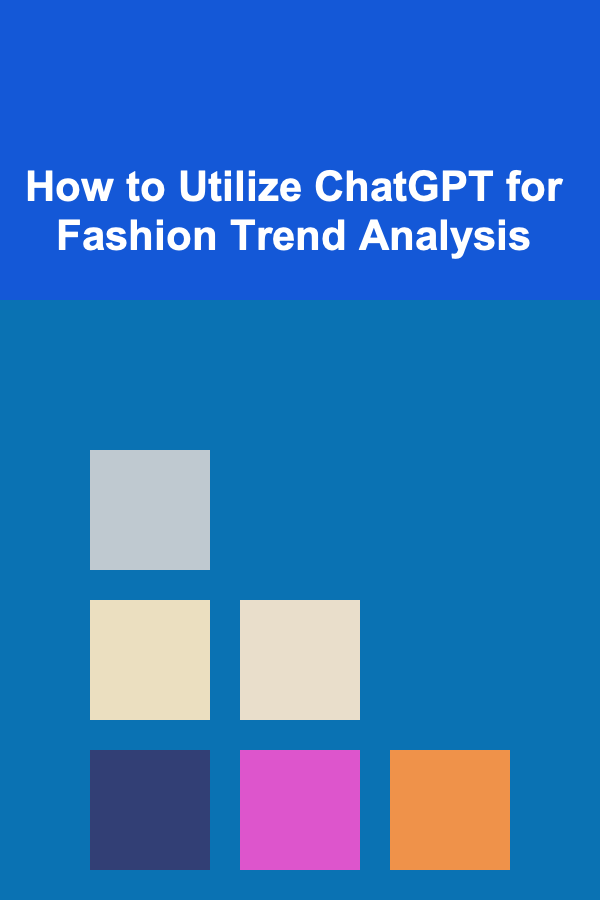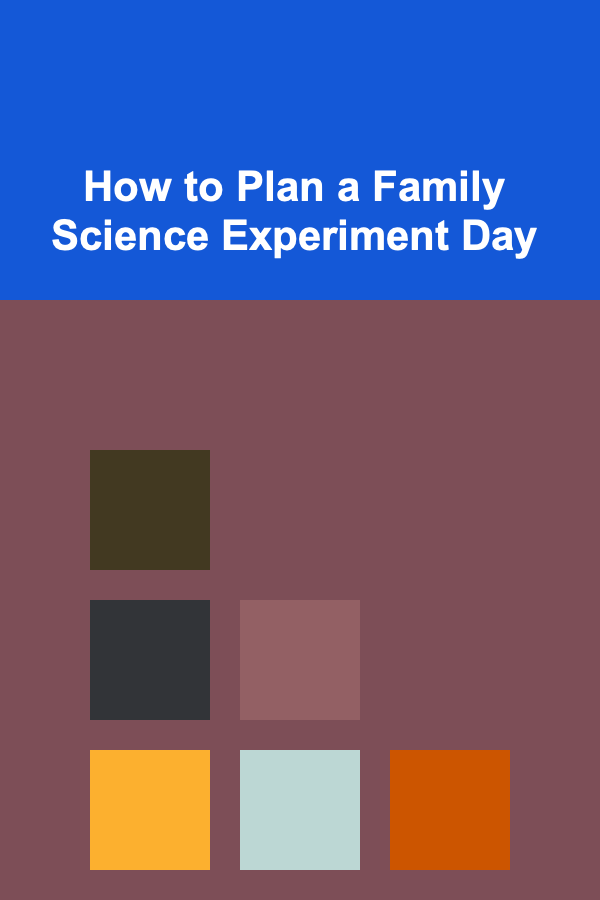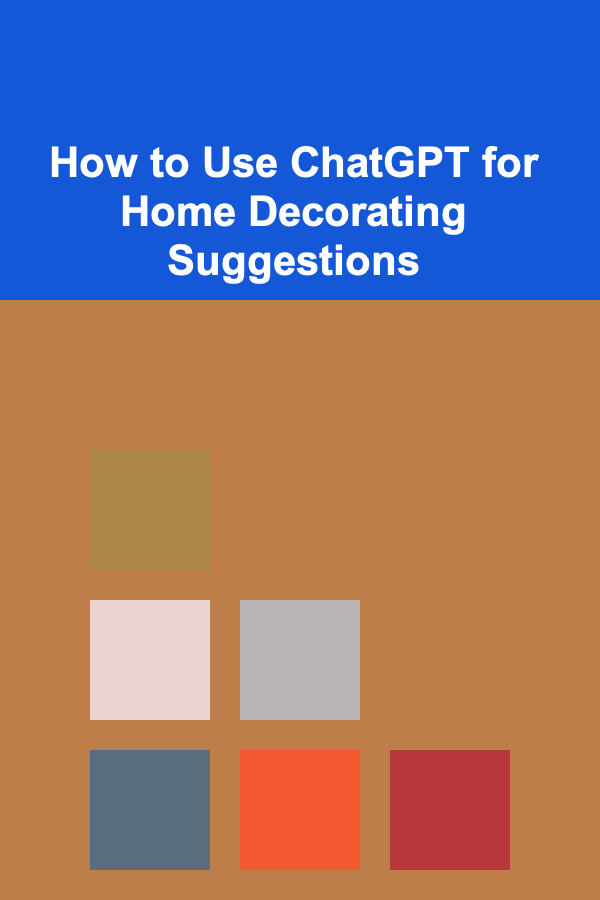
How to Utilize ChatGPT for Fashion Trend Analysis
ebook include PDF & Audio bundle (Micro Guide)
$12.99$9.99
Limited Time Offer! Order within the next:

The world of fashion is constantly evolving, with trends shifting season by season. In an industry driven by creativity and consumer behavior, staying on top of the latest fashion trends is crucial for designers, marketers, and brands. Traditionally, fashion trend forecasting has relied on data from runway shows, street style, and consumer feedback, but in the digital age, technology has become an indispensable tool in this process.
Among the most advanced tools available today is ChatGPT , an AI language model developed by OpenAI. With its powerful natural language processing (NLP) capabilities, ChatGPT can be used for a variety of applications in the fashion industry, including trend analysis. In this article, we will explore how ChatGPT can be utilized for fashion trend analysis, providing insights into its capabilities, applications, and the potential impact on the fashion ecosystem.
What is ChatGPT and How Does it Work?
ChatGPT is a Generative Pretrained Transformer (GPT) language model designed to understand and generate human-like text. It is powered by deep learning techniques that analyze vast amounts of text data, enabling it to recognize patterns, generate meaningful responses, and engage in conversations on a wide range of topics.
In the context of fashion trend analysis, ChatGPT can provide valuable insights by processing large datasets, drawing connections between historical trends and current consumer preferences, and offering predictions about future fashion developments. By leveraging ChatGPT's natural language processing power, fashion professionals can make more informed decisions when it comes to product development, marketing strategies, and consumer engagement.
The Role of ChatGPT in Fashion Trend Analysis
Fashion trend analysis involves identifying shifts in consumer preferences, tracking the popularity of particular styles, colors, fabrics, and silhouettes, and predicting what will be fashionable in the coming seasons. Traditional methods of trend forecasting rely on the expertise of industry insiders, runway shows, fashion magazines, and social media influencers. While these sources remain important, ChatGPT offers a unique advantage by processing vast amounts of text from diverse sources in real-time. Here's how ChatGPT can enhance fashion trend analysis:
1. Data Processing and Analysis
ChatGPT is capable of processing massive amounts of unstructured text data from various sources, including fashion blogs, online magazines, social media, product reviews, and more. By analyzing this data, ChatGPT can identify key trends, detect emerging styles, and predict shifts in consumer preferences. It can also detect the subtle nuances of language, picking up on emerging keywords, hashtags, and phrases that may signal a trend.
For example, ChatGPT can track fashion-related discussions on Twitter, Instagram, and Reddit, where users often post about the latest trends, share photos, and engage in conversations about what they are wearing. By analyzing these conversations, ChatGPT can help identify rising trends and provide early insights into what will dominate the fashion landscape.
2. Sentiment Analysis and Consumer Behavior Insights
Understanding consumer sentiment is a critical aspect of fashion trend analysis. ChatGPT can perform sentiment analysis, determining whether public opinion on specific fashion items or trends is positive, negative, or neutral. This allows fashion brands and designers to gauge how well certain styles or collections are being received by the public.
For example, by analyzing the sentiment surrounding a particular designer's new collection, ChatGPT can provide valuable feedback on how well the collection resonates with consumers. It can also detect shifts in sentiment over time, allowing fashion professionals to anticipate changes in consumer tastes.
3. Trend Prediction
One of the most powerful capabilities of ChatGPT is its ability to make predictions about future trends. By analyzing historical data, understanding patterns in consumer behavior, and recognizing emerging linguistic trends, ChatGPT can provide predictions about which fashion styles, colors, fabrics, or silhouettes are likely to gain traction in the coming months.
For instance, ChatGPT could predict that oversized denim jackets are going to make a comeback by analyzing language patterns from fashion influencers, past collections, and consumer reviews. This predictive power is invaluable for designers and marketers looking to stay ahead of the curve and capitalize on emerging trends.
4. Creative Inspiration for Fashion Design
Fashion designers often seek inspiration from a wide range of sources, from art and culture to nature and technology. ChatGPT can serve as a creative partner, offering unique design ideas, color palettes, fabric suggestions, and even fashion themes based on current trends and historical fashion data.
By providing descriptions and suggestions for innovative design concepts, ChatGPT can help designers break out of creative blocks and explore new possibilities. It can also help designers understand the cultural and societal context of a trend, allowing them to create collections that resonate with contemporary consumer values and needs.
5. Competitive Analysis
In the competitive world of fashion, staying informed about what other brands and designers are doing is essential. ChatGPT can conduct competitive analysis by reviewing content from fashion publications, brand websites, social media accounts, and interviews. By analyzing this information, ChatGPT can provide insights into what competitors are focusing on, whether it's a particular fabric, color scheme, or design aesthetic.
This allows fashion brands to refine their strategies, adjust their product offerings, and ensure they are not falling behind in terms of design or market positioning. Additionally, ChatGPT can help identify gaps in the market where competitors may not be addressing consumer demands, creating opportunities for innovation.
6. Social Media Monitoring and Engagement
Social media plays a huge role in shaping fashion trends today. Influencers, celebrities, and consumers alike use platforms like Instagram, TikTok, and Twitter to showcase the latest styles and share their fashion choices. ChatGPT can monitor social media activity, track hashtags, and identify emerging trends by analyzing the language and content shared by users.
Moreover, ChatGPT can generate social media posts, captions, and promotional content tailored to specific fashion trends, allowing brands to engage with their audience more effectively. This makes ChatGPT not only a tool for analysis but also for active participation in trend-driven conversations online.
7. Trend Visualization and Reporting
While ChatGPT excels at processing and analyzing textual data, it can also assist in creating comprehensive reports and visualizations for fashion professionals. By summarizing trend data, providing insights, and visualizing key fashion shifts, ChatGPT can help designers, brands, and retailers make data-driven decisions.
For example, ChatGPT can generate reports that highlight the most popular fashion trends for a specific season, broken down by category (e.g., colors, fabrics, silhouettes). These reports can be shared with design teams, marketing departments, and stakeholders to inform decision-making processes.
How to Use ChatGPT for Fashion Trend Analysis
To effectively utilize ChatGPT for fashion trend analysis, fashion professionals should integrate it into their existing workflows. Here are some steps to get started:
1. Gather Data from Fashion Sources
The first step is to gather a diverse range of data sources. This could include fashion magazines, blogs, social media platforms, e-commerce websites, and consumer reviews. The more diverse and comprehensive the data, the better ChatGPT will be at identifying trends.
2. Feed Data into ChatGPT
Once you have gathered your data, input it into ChatGPT for analysis. This can be done by using the OpenAI API or other tools that integrate ChatGPT into fashion trend analysis workflows. By processing large volumes of data, ChatGPT can help identify emerging trends, detect changes in consumer sentiment, and provide actionable insights.
3. Ask Specific Questions
ChatGPT can provide more targeted insights when asked specific questions. For example, you can ask:
- "What are the top fashion trends for Spring 2025?"
- "How is the public responding to sustainable fashion brands?"
- "What colors are expected to dominate the upcoming season?" By asking specific questions, you can tailor ChatGPT's output to meet your needs and gain focused insights.
4. Use ChatGPT for Competitor Research
Regularly use ChatGPT to conduct competitor research by analyzing the language used by other brands and fashion designers. This can help you stay informed about industry movements, identify gaps in the market, and ensure that your designs remain competitive.
5. Incorporate Sentiment Analysis
Perform sentiment analysis on emerging trends to gauge public opinion. Use ChatGPT to monitor social media discussions and fashion forums to get real-time feedback on what consumers think about specific trends.
6. Visualize Data
Create clear and concise reports based on the insights generated by ChatGPT. Use these reports to guide creative decisions, marketing campaigns, and product development processes.
Conclusion
ChatGPT represents a revolutionary tool for fashion trend analysis. By leveraging its powerful natural language processing abilities, fashion professionals can gain a deeper understanding of emerging trends, consumer behavior, and market dynamics. ChatGPT enables quicker, more data-driven decision-making, offering insights that would otherwise require significant time and resources to gather manually.
As the fashion industry continues to embrace digital tools and technologies, the role of AI-driven platforms like ChatGPT will only become more integral to the creative and business aspects of fashion. By utilizing ChatGPT effectively, fashion brands can stay ahead of the curve, drive innovation, and create designs that resonate with the modern consumer.
Reading More From Our Other Websites
- [Home Space Saving 101] How to Organize a Tiny Kitchen for Maximum Functionality
- [Personal Care Tips 101] How to Apply Hair Serum for Maximum Benefits
- [Personal Financial Planning 101] How to Teach Kids About Money Management
- [Personal Financial Planning 101] How to Effectively Manage Money in a Recession: Protecting Your Finances When the Economy Falters
- [Home Renovating 101] How to Plan a Successful Kitchen Remodel from Start to Finish
- [Organization Tip 101] How to Create a Mobile Office Supply Kit
- [Gardening 101] Eco‑Friendly Pest Solutions: Protect Your Garden Without Harmful Chemicals
- [Personal Care Tips 101] How to Choose the Best Blush for Sensitive Skin
- [Personal Investment 101] How to Maximize Returns with a Money Market IRA
- [Home Space Saving 101] How to Save Space in Your Kids' Room with Creative Solutions

How to Decorate Your Home with Functional Yet Affordable Storage Solutions
Read More
How to Make a Checklist for Safety Inspections in Laboratories
Read More
How to Plan a Family Science Experiment Day
Read More
How to Use ChatGPT for Home Decorating Suggestions
Read More
Blockchain for Intellectual Property Rights Protection: A Comprehensive Guide
Read More
10 Tips for Staying Organized During Event Season
Read MoreOther Products

How to Decorate Your Home with Functional Yet Affordable Storage Solutions
Read More
How to Make a Checklist for Safety Inspections in Laboratories
Read More
How to Plan a Family Science Experiment Day
Read More
How to Use ChatGPT for Home Decorating Suggestions
Read More
Blockchain for Intellectual Property Rights Protection: A Comprehensive Guide
Read More